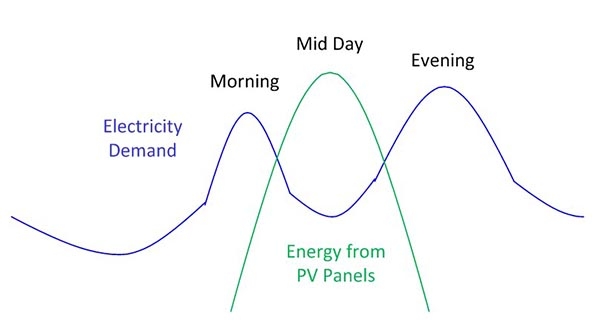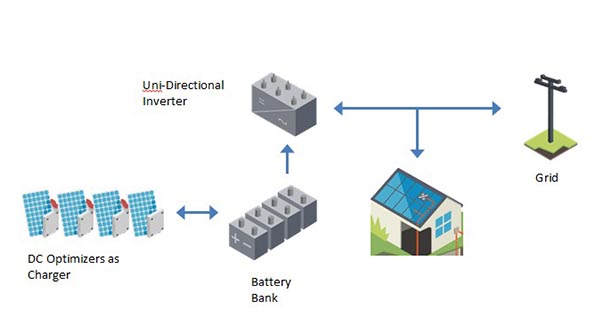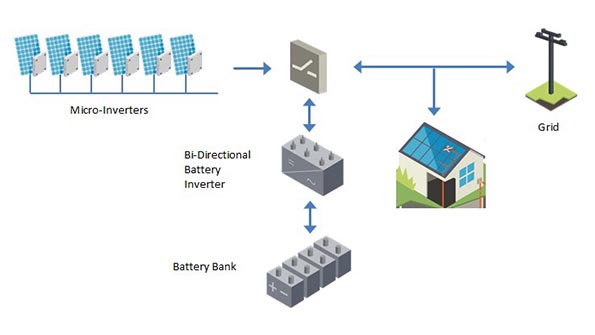
1. Typical daily residential energy demands.
“Going off the grid” is being considered as better batteries and power electronics make it possible to power a home without using the utility grid. Off-grid means there is no connection to a utility company at all. If we are going to go off-grid then we must investigate several issues:
- We need a source of energy, the sun
- We need to harvest that energy, PV panels
- We need to convert that energy into AC power, using inverters and micro-inverters
So far so good, we have a source of energy, the means to harvest it and the method to make it useful.
Next we need to look at energy consumption of a typical home, as shown in Fig. 1. The large energy demand is in the morning when everyone is getting ready to go to work or school, and later in the evening when everyone returns home, cooks meals, does the laundry and turns on the lights and watches the TV. In contrast, the energy produced by PV panels is highest when the sun reaches mid-day.
Immediately we can see that the energy produced can have a different profile from the energy demand. In an off-grid situation, PV panels could fail to power a household when the demand is high and produce too much power when no one is home. Storage is the solution to balancing the demand vs generation.
Solar Inverters Can Improve Power Quality
The average North American household uses about 30kWh of electricity in a day. Depending on the amount of sun or cloud cover, a 10kW PV panel system can produce 25kWh to 70kWh in June and 10kWh to 40kWh per day in December.
There are situations where electricity is not suitable for all applications. In cold regions, where the winter electricity consumption is much higher than the average of 30kWh, 10 to 40kWh per day from PV panels would not be sufficient. Winter heating with electricity can consume an average of over 200kWh per day. A 10kW system simply won’t do and supplementing with a 5kW generator still could not handle the load. Further, what happens when the sun disappears for a few days?
The cost of a 7kWh Tesla Powerwall is $3000, US. Installing 7 would cost $21,000, give you roughly 50kWh and would provide you energy for just over a day and a half. This is adequate for many regions, but not for the winter in cold parts of the world. For the immediate future, going off-grid in cold climates will require the use of fossil fuels.
To better understand the costs, consider the battery system as an energy savings account. The average cost for electricity in the US is about 13˘ per kWh. A 7kWh battery can store 7 times 13˘ or 91˘ total. Each $3000 battery could store less than a dollar of energy.
There has been lots of discussion that solar energy is reaching parity with the grid. This is a true statement because the grid is there as a backup. These statements are made without considering the cost of storage. When batteries are introduced into the calculation, we still have a way to go before we reach a true parity.
The good work that battery companies like Tesla is doing will eventually result in lower cost and higher storage capacity. For the moment, our energy demands are simply too high for the average household to go completely off-grid.
Practical Applications
Let’s move going completely off-grid to somewhere in the future and consider that today there are practical applications for solar energy.
UPS is a very practical application if you are in an area where the power goes off frequently. Batteries can be charged from PV panels. A method to keep battery costs down by limiting the number of batteries required is to install a critical load sub panel. An electrician can install this panel near your house electrical panel. This sub panel would have only the essential circuits that you want to keep running during an outage. Having fewer appliances to run means less batteries are required.
Once our batteries are fully charged any excess energy from the PV panels can be delivered to the utilities. There are two popular programs available depending on where you live. One is called net metering; in this case the meter flows backwards when energy is provided to the grid. The other is called feed-in tariff, where an additional meter is installed that keeps track of the energy provided to the grid. This application uses an inverter or micro-inverters to convert the DC from the panels to AC.
Another application is to limit time-of-use charges. This is where the utility company varies prices depending on the time-of-day. In many areas the utility companies are charging a premium for energy at certain hours of the day. A practical application is to use the batteries to power a house during these hours to limit the more expensive rates.
Another battery application is something called arbitrage. If the local utility company pays a higher rate to buy back electricity at peak hours then we can store the electricity from the grid in batteries when the rates are low and then sell it back to the utilities at the higher rate. In order for this to be practical the difference in the two rates needs to make economic sense.
Equipment Requirements
There are several configurations that can be used:
- You can install DC Chargers (Fig. 2) on the PV panel output to charge the batteries using a DC voltage. To use the energy in the batteries, an inverter is connected to the batteries to convert the DC to AC. This AC can feed the house or the grid. As the current flows from the batteries through the inverter in one direction this is called a uni-directional battery inverter.

- Another configuration is to use either micro-inverters or a string inverter (Fig. 3) to convert the DC voltage from the PV panels to AC. The AC can be used to feed the house or the grid. When we want to use this energy to charge the batteries, we need to use a bi-directional battery inverter. This is because the AC from the micro-inverters or inverter must be converted to DC in this inverter to charge the batteries. Then when we want to use the batteries, the DC is converted back to AC in this inverter. It is called a bi-directional inverter because the current flows through the inverter in both directions.
We have identified some main hardware pieces that can be used with the batteries:
- DC chargers
- Micro-inverters
- Uni-directional battery inverter
- Bi-directional battery inverter
These products all contain Module Level Power Electronics (MLPE). The affordability of MLPE is another key component to widespread adoption of the distributed power generation revolution. At Solantro we are designing chips and platforms to enable the manufacture of low cost DC chargers, micro-inverters, uni-directional and bi-directional battery inverters.

To address MLPE cost reduction, Solantro combined power systems expertise with circuit integration to develop a family of ICs performing all the main functions in power conversion topologies: power train sensing, event processing and power switching drivers. Lower BOM costs are made possible by the high integration level achieved by the ICs. Real-time control makes possible power conversion topologies to operate at higher switching frequencies, which has a direct impact on reducing the size of the printed circuit board, magnetics and capacitors.
While the dream of going off-grid is still somewhat in the future, today we have real applications that can take advantage of recent advancements in battery technology. The missionary work that companies such as Tesla is doing is creating a market that hasn’t existed before.
When batteries reach the point where they are practical for the average household, affordable MLPE products need to be ready to take advantage of these battery advancements.
Copyright © 2015 Penton